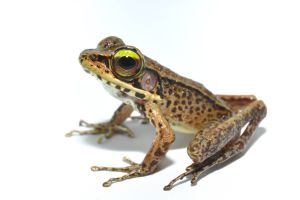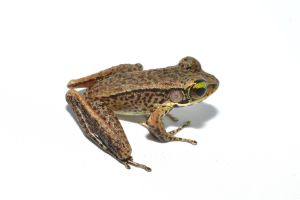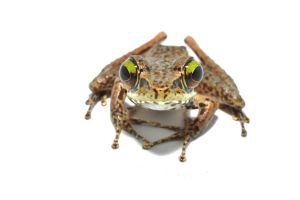
Frogs of Borneo

Frogs of Borneo

Frogs of Borneo

Frogs of Borneo

Frogs of Borneo

Frogs of Borneo

Frogs of Borneo

Frogs of Borneo

Frogs of Borneo

Frogs of Borneo

Frogs of Borneo
macrophthalmus
Big-eyed Torrent Frog
In the scientific literature, Meristogenys macrophthalmus is known from only one specimen—the holotype. It is an adult male from Bintulu District, Sarawak, collected in 1964 by William Hosmer and described as a new species by Matsui (1986). Females remain unknown.
The photos we provide depict a specimen from Sarawak, east of Bintulu. We tentatively (!) assign it to this species based on its large eyes, the name-giving feature of the species.
The species can be described as moderately stout. The head is as long as it is broad. The snout is rather blunt, projecting slightly beyond the lower jaw. The eyes are elevated and large, with the eye diameter greater than the snout length. Canthi are distinct and slightly concave; lores oblique and concave. Nostrils are lateral, positioned below the canthus, and distinctly closer to the tip of the snout than to the eye. The eardrum is distinct, its diameter greater than one-half the length of the eye, and separated from the eye by one-fourth of the eardrum’s diameter. Paired subgular vocal sacs form gular pouches at the corners of the throat; vocal openings are located just inside the commissures of the jaws.
The fingers are moderately slender, with the first and second similar in length. Fingertips are expanded into disks with circummarginal grooves. There are no supernumerary metacarpal tubercles. Distinct nuptial pads cover the dorsal and median surfaces of the first finger from its base to the subarticular tubercle. Toe disks are similar in shape and size to those of the fingers. The feet are fully webbed, with webbing extending to the disks of all toes. A narrow fringe of skin is present along the medial edge of the first toe. Inner and outer metatarsal tubercles are present on the underside of the foot.
The skin is shagreened above. At the transition from back to flank, low glandular dorsolateral folds are present. The sides of the trunk (flanks) are coarsely granular. The throat is smooth; the chest and abdomen are rugose. The original description of the species was based on a preserved specimen, so the appearance of the holotype in life remains unknown. In preservation, the rear of the thigh is dark brown with small, irregular light spots.
More research is needed to resolve the mysteries surrounding this species.
Version tracking
-
14.08.2025
updated


